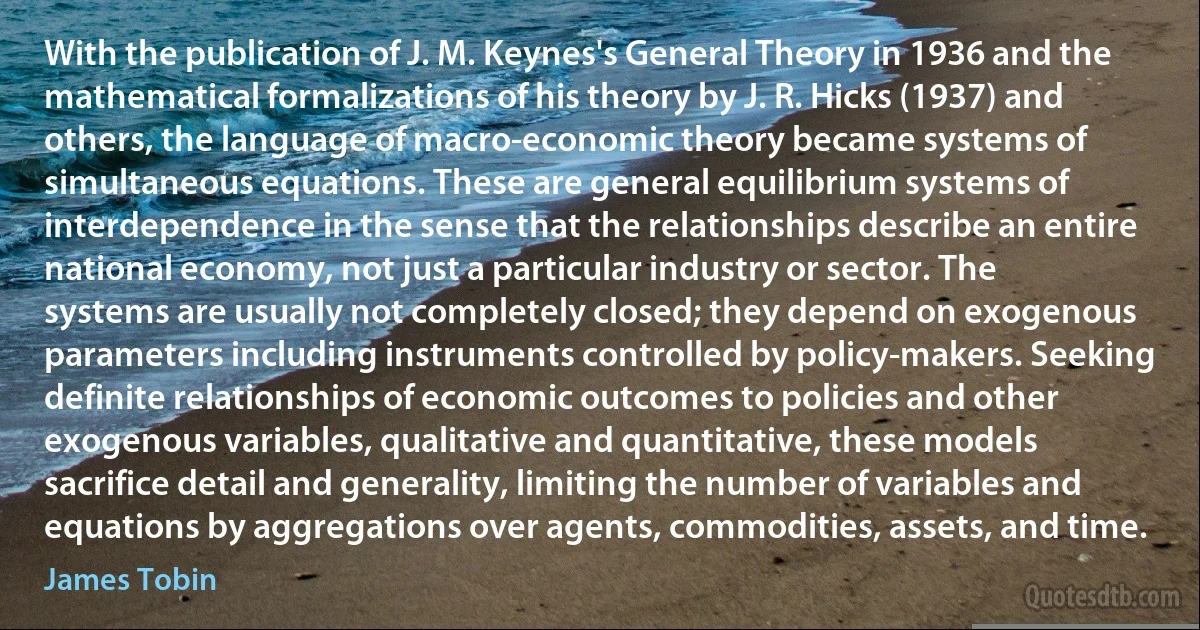
With the publication of J. M. Keynes's General Theory in 1936 and the mathematical formalizations of his theory by J. R. Hicks (1937) and others, the language of macro-economic theory became systems of simultaneous equations. These are general equilibrium systems of interdependence in the sense that the relationships describe an entire national economy, not just a particular industry or sector. The systems are usually not completely closed; they depend on exogenous parameters including instruments controlled by policy-makers. Seeking definite relationships of economic outcomes to policies and other exogenous variables, qualitative and quantitative, these models sacrifice detail and generality, limiting the number of variables and equations by aggregations over agents, commodities, assets, and time.
James TobinRelated topics
assets control definite entire equilibrium general generality industry interdependence language limiting national number publication qualitative sector seeking sense time othersRelated quotes
Barack Obama has failed America. When he took office, the economy was in recession. He made it worse. And he made it last longer. Three years later, over 16 million Americans are out of work or have just quit looking. Millions more are underemployed. Three years later, unemployment is still above 8%, a figure he said his stimulus would keep from happening. Three years later, foreclosures are still at record levels. Three years later the prices of homes continue to fall. Three years later, our national debt has grown nearly as large as our entire economy. Families are buried under higher prices for food and higher prices for gasoline. It breaks my heart to see what's happening in this country. These failing hopes make up President Obama's own misery index. It's never been higher.

Mitt Romney
People always talk about human sacrifice as if it were an unusual and aberrant activity,” she said thoughtfully. "Over the centuries, it's really been fairly common in a number of societies. Think about it. There're a number of religions in the United States whose worship centers on a particular human sacrifice.” She glanced at me.
"Jesus Christ on the cross,” I said slowly.
"Certainly. Thousands of people consume Christ's body and blood each Sunday.”
"That's different.”
She shrugged. "Not really. Christ died long ago in a faraway place, and that might make it seem different. His worshipers claimed he was God incarnate, but the Aztecs claimed the same for the god-king they sacrificed. It happened only once, and that speaks for moderation on the part of the Christians, but that's not a fundamental difference, just one of degree.

Pat Murphy
The sin of bourgeois patriotism was to confound a certain economic form with the national. It connected two things that are entirely different. Forms of the economy, however firm they may seem, are changeable. The national is eternal. If I mix the eternal and the temporal, the eternal will necessarily collapse when the temporal collapses. This was the real cause for the collapse of liberal society. It was rooted not in the eternal, but in the temporal, and when the temporal declined it took the eternal down with it. Today it is only an excuse for a system that brings growing economic misery. That is the only reason why international Jewry organizes the battle of the proletarian forces against both powers, the economy and the nation, and defeat them.

Joseph Goebbels
When we approach the study of business cycle with the intention of carrying through an analysis that is truly dynamic and determinate in the above sense, we are naturally led to distinguish between two types of analyses: the micro-dynamic and the macro-dynamic types. The micro-dynamic analysis is an analysis by which we try to explain in some detail the behaviour of a certain section of the huge economic mechanism, taking for granted that certain general parameters are given. Obviously it may well be that we obtain more or less cyclical fluctuations in such sub-systems, even though the general parameters are given. The essence of this type of analysis is to show the details of the evolution of a given specific market, the behaviour of a given type of consumers, and so on.

Ragnar Frisch
The Doomsday Machine is not sufficiently controllable. Even though it maximizes the probability that deterrence will work (including minimizing the probability of accidents or miscalculations), it is totally unsatisfactory. One must still examine the consequences of a failure. In this case a failure kills too many people and kills them too automatically. There is no chance of human intervention, control, and final decision.And even if we give up the computer and make the Doomsday Machine reliably controllable by the decision makers, it is still not controllable enough. Neither NATO nor the United States, and possibly not even the Soviet Union, would be willing to spend billions of dollars to give a few individuals this particular kind of life and death power over the entire world.

Herman Kahn
